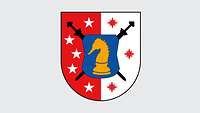
1 Corvette Squadron
The vessels of 1 Corvette Squadron control maritime areas even close to shore.


The future seventh corvette of the German Navy received a traditional name on 4 May in Hamburg.
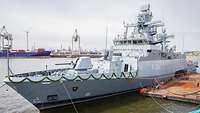
The “Emden”: She is the second vessel of the second construction batch of the Braunschweig class respectively Type 130 corvettes. According to NATONorth Atlantic Treaty Organization standards she already qualifies as a frigate, thus the “F” of her pennant number “F 266”.
Bundeswehr/Nico TheskaThe godmother of the new ship is Annette Lehnigk-Emden, since 27 April President of the Federal Office of Bundeswehr Equipment, Information Technology and In-Service Support (BAAINBwBundesamt für Ausrüstung, Informationstechnik und Nutzung der Bundeswehr). For her, the christening was special in two ways: on the one hand, the ceremony at the Blohm+Voss shipyard was her first ship christening as the new head of the Office. On the other hand, her own family history connects her with the ship’s name, which is steeped in tradition.
Three cruisers of the Imperial Navy and the Reichsmarine as well as two frigates of the Navy of the Federal Republic of Germany had already been named after the city of Emden in East Frisia on Germany’s North Sea coast. Ten years after the decommissioning of the last “Emden”, a Bremen-class frigate, a sixth German warship now bears the prestigious name again.
“I am proud that I was able to christen this ship ‘Emden’ so soon after my appointment as President of the BAAINBwBundesamt für Ausrüstung, Informationstechnik und Nutzung der Bundeswehr,” said Lehnigk-Emden. Her grandfather had been a crew member of the “Emden (I)”. The light cruiser of the German Imperial Navy had led a successful privateering campaign in the Indian Ocean at the beginning of World War One, but had been sunk by the cruiser HMSHis/Her Majesty's Ship “Sydney” of the fledgling Royal Australian Navy in November 1914.
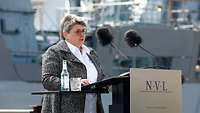
Annette Lehnigk-Emden during her christening speech for the “Emden”
NVL GroupGrandfather Richard Lehnigk had survived the battle and endured the war in captivity. Like the entire ship’s company, he and his descendants had received personal permission from the Kaiser to add the suffix “-Emden” to their surnames as a reminder of the cruiser’s achievements.
Today, his granddaughter Annette Lehnigk-Emden bears a completely different responsibility. As a senior BAAINBwBundesamt für Ausrüstung, Informationstechnik und Nutzung der Bundeswehr employee for many years, she had already been involved with the supplementary procurement of the Type 130 corvettes since 2016, among many other projects.
“We are experiencing a historical turning point and a rethinking of the Bundeswehr with the aim of ensuring a defence-oriented democracy in our country,” said Lehnigk-Emden in her christening speech. In terms of implementation, this change of times also required the Equipment Office BAAINBwBundesamt für Ausrüstung, Informationstechnik und Nutzung der Bundeswehr to act more efficiently and at the same time with legal certainty in order to quickly achieve visible results with regard to the quality and quantity of equipment.
“We in the Office are the ‘motor’ of the turning point,“ she explained about this responsibility. The BAAINBwBundesamt für Ausrüstung, Informationstechnik und Nutzung der Bundeswehr’s specifications, she said, are to effectively implement the almost 26 billion euros to be spent in the 2023 budget as well as the Bundeswehr’s special assets of 100 billion euros. “So if we succeed in increasing maritime striking power by providing new and operational vessels for the navy – then they will also be able to perform their future tasks of national and alliance defence as part of operational armed forces.”
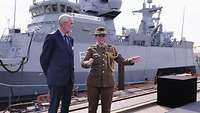
The new naval vessel ties in with a lot of history and emotion. Former Commodore Henning Bess, head of the “Emden family”, and Major Jess Ward, Australia’s Assistant Defence Attaché in Berlin, were two of the many christening guests.
Bundeswehr/Marcus MohrLehnigk-Emden said that all those involved in the corvette project deserve recognition and respect. Those involved so far include above all the employees of the naval department in the BAAINBwBundesamt für Ausrüstung, Informationstechnik und Nutzung der Bundeswehr as well as those of the Shipbuilding Working Group K130 (Arbeitsgemeinschaft K130/ARGE K130) as contractors. They will soon be joined by the first crew of the Germany Navy’s 1 Corvette Squadron. The latter came to Hamburg with a delegation for the christening of their ship. They will get on board in autumn to begin trials of the “Emden (VI)” in spring 2024 together with a crew from the shipyard.
Before that, the vessel is already being fitted out. At the Hamburg shipyard belonging to Naval Vessels Lürssens, hundreds of subcontractors of ARGE K130 are adding their work to turn a complex system into a functioning corvette. For example, the Bavaria-based company Hensoldt is supplying the TRS-4D sea surveillance radar, an upgrade compared to the first five corvettes of the class. A new computer network, a so-called command and weapons control system, in the corvette’s combat information centre is to serve as an interface between sensors such as the sea surveillance radar, the ship’s armament and the other systems.
The German Navy’s fleet commander, Vice Admiral Frank Lenski, openly addressed related information technology problems at the naming ceremony. He said, however, that he was sure public clients and industry would jointly bring the project to a good end “despite the delays due to the lack of provision of an ITInformationstechnik security-compliant command and weapons control system”.
The “stumbling block” of ITInformationstechnik security forces further patience, Lenski said. However, this should not diminish his thanks to the project team, but should rather be an incentive. For the Navy needs these important vessels quickly.
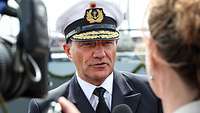
The Commander of the German Fleet, Vice Admiral Frank Lenski, was the highest-ranking guest of Germany’s naval forces as Deputy Chief of Navy. Here, he is being interviewed by local media on the occasion of the ship’s christening.
Bundeswehr/TheskaFor Lenski, the Braunschweig class is finding its way back to its original purpose from the late 1980s in view of the tense security situation. “Our corvettes were originally conceived as ‘warfighters’ in the marginal seas,” the admiral said. “Their intended area of operations today will once again become primarily the northern flank of the Alliance area.” For the Russian Navy, as a potential adversary of NATONorth Atlantic Treaty Organization in this maritime area, had not let time pass idly by. According to the current state of affairs, it would even emerge stronger from the war against Ukraine, said Lenski.
All those responsible who spoke at the christening of the new corvette were confident. Above all, the tradition of a naval vessel with the name “Emden” makes it clear that it is not technology alone that counts. This was expressed by the Lord Mayor of the sponsoring city, Tim Kruithoff: “The ‘Emden’ embodies the strength and courage of our Navy.”
BAAINBwBundesamt für Ausrüstung, Informationstechnik und Nutzung der Bundeswehr President Lehnigk-Emden concluded by reminding the audience to focus on the big picture when it comes to corvette construction, while at the same time looking ahead: “The overall order has not yet been completed, the second batch has not yet been fully processed. And with the eleventh vessel, the third batch is already in the starting blocks.”
by Marcus Mohr emailA warship with the name “Emden” already existed in the Imperial Navy. The light cruiser, commissioned in 1909 and stationed in East Asia since 1913, was extremely successful in the trade war in the Indian Ocean at the beginning of the First World War. In November 1914, however, the cruiser HMASHis/Her Majesty's Australian Ship “Sydney” of the Royal Australian Navy put the German ship out of action. This Battle of Cocos was the first naval action of independent Australian naval forces.
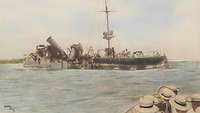
Ships cutters of HMASHis/Her Majesty's Australian Ship “Sydney” steer towards the destroyed “Emden”, shortly after she struck her colours, to rescue the surviving German sailors. Contemporary hand-coloured photograph
State Library of New South Wales
Yet before and after “Emden’s” destruction all opponents paid their respects to the honourable conduct of her captain and his crew. For example, The London Times wrote: “We are pleased that the cruiser Emden was finally destroyed but we acknowledge Commander Von Muller as a valiant and chivalrous adversary.”
Kaiser Wilhelm II decreed that a new warship of his navy should bear the name again – and the Iron Cross as a bow decoration and reminder of the deeds of its predecessor. A tradition was born. The “Emden (III)” of the Reichsmarine of the Weimar Republic carried on the tradition. In 2013, after the decommissioning of the frigate “Emden (V)” of the German Navy, this ship’s decoration has been presented to Australia by then German Chief of Navy Vice Admiral Axel Schimpf.
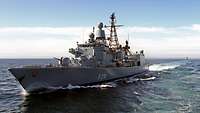
Frigate “Emden (V)” 2012 in the North Atlantic. The Iron Cross, which the German Navy donated to the Royal Australian Navy a year later, can be seen under the windows of the bridge.
Bundeswehr/Björn Wilke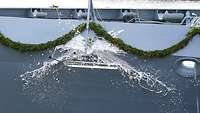
The bursting of the champagne bottle marks the christening moment. The godmother traditionally said: “I hereby christen you ‘Emden’ and wish you always a good journey and always a hand’s breadth of water under your keel.”
Bundeswehr/Nico Theska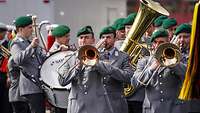
“Highland Cathedral”, “Free as the Wind” and more: The Neubrandenburg Army Music Corps accompanied the festive ceremony.
Bundeswehr/Nico Theska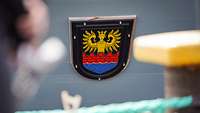
The coat of arms of the city of Emden on the bow of the new corvette. As with the other vessels of the navy, it will be the only external ship decoration.
Bundeswehr/Nico Theska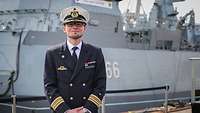
Commander Sebastian Lehmann-Dowall bears special responsibility as designated first commanding officer of the new “Emden”. At the moment, his crew consists of only a dozen members, but will gradually be completed by the time the ship enters service.
Bundeswehr/Nico Theska